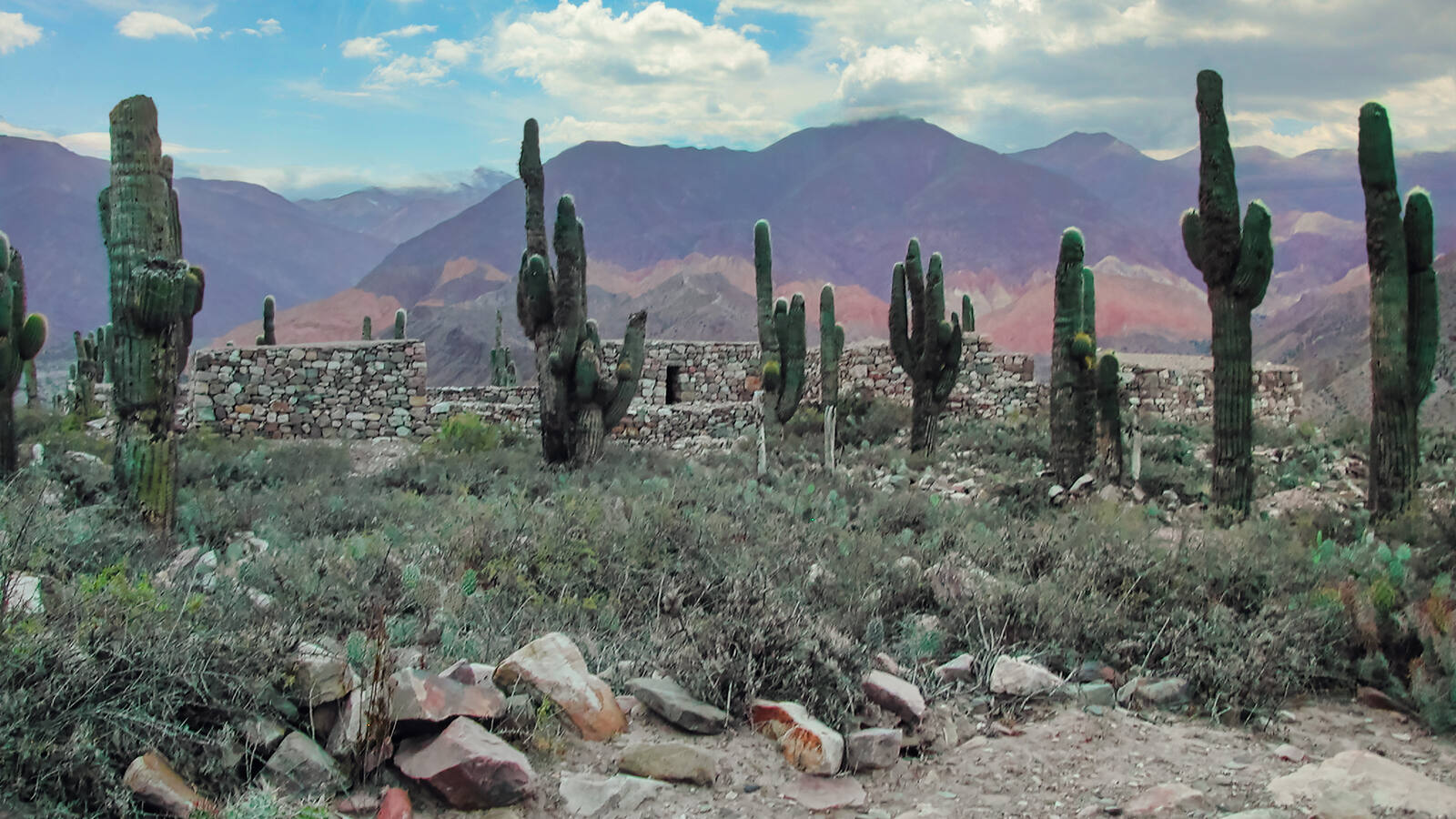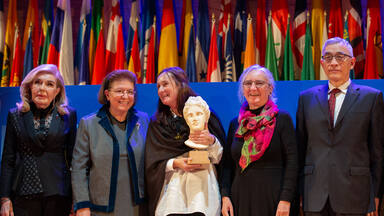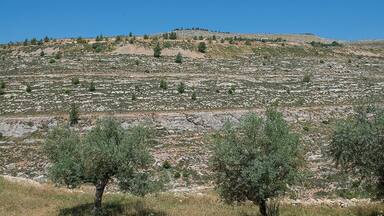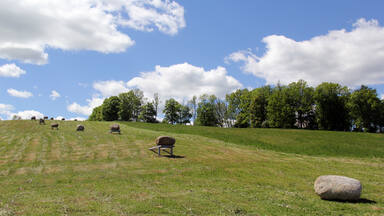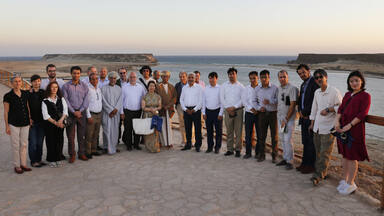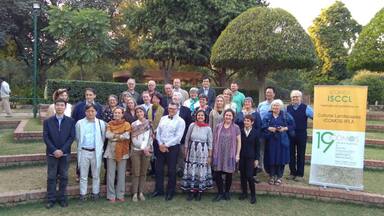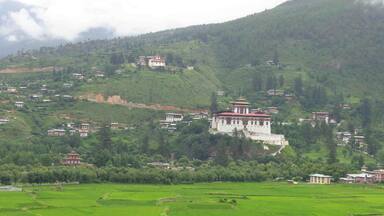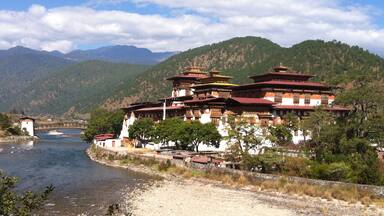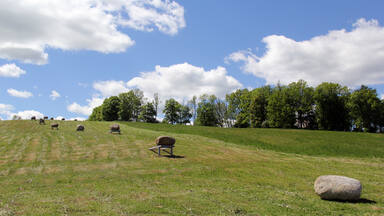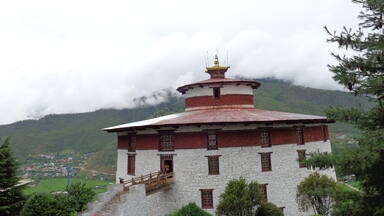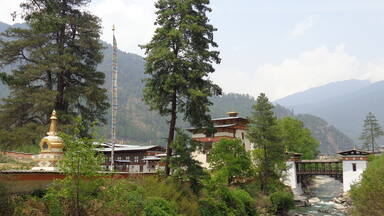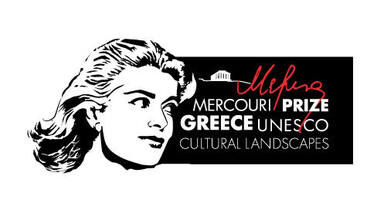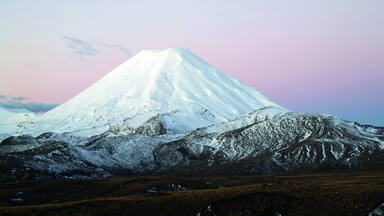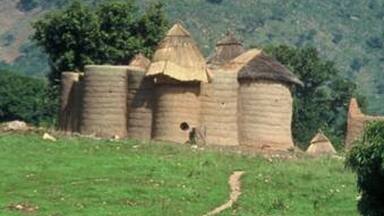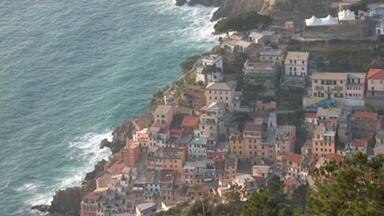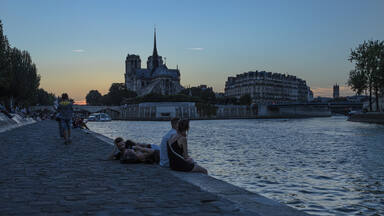There exist a great variety of Landscapes that are representative of the different regions of the world. Combined works of nature and humankind, they express a long and intimate relationship between peoples and their natural environment.
Table of Contents
Certain sites reflect specific techniques of land use that guarantee and sustain biological diversity. Others, associated in the minds of the communities with powerful beliefs and artistic and traditional customs, embody an exceptional spiritual relationship of people with nature.
To reveal and sustain the great diversity of the interactions between humans and their environment, to protect living traditional cultures and preserve the traces of those which have disappeared, these sites, called cultural landscapes, have been inscribed on the World Heritage List.
Cultural landscapes -- cultivated terraces on lofty mountains, gardens, sacred places ... -- testify to the creative genius, social development and the imaginative and spiritual vitality of humanity. They are part of our collective identity.
To date, 121 properties with 6 transboundary properties (1 delisted property) on the World Heritage List have been included as cultural landscapes.
Afghanistan
Andorra
Argentina
Australia
Austria
Azerbaijan
Belgium
Brazil
Canada
Chad
China
Colombia
Cuba
Czechia
Denmark
Ethiopia
France
- Pyrénées - Mont Perdu *
- Jurisdiction of Saint-Emilion
- The Loire Valley between Sully-sur-Loire and Chalonnes 2
- The Causses and the Cévennes, Mediterranean agro-pastoral Cultural Landscape
- Nord-Pas de Calais Mining Basin
- Champagne Hillsides, Houses and Cellars
- The Climats, terroirs of Burgundy
- Taputapuātea
Gabon
Germany
Hungary
Iceland
India
Indonesia
Iran (Islamic Republic of)
Israel
Italy
- Costiera Amalfitana
- Portovenere, Cinque Terre, and the Islands (Palmaria, Tino and Tinetto)
- Cilento and Vallo di Diano National Park with the Archeological Sites of Paestum and Velia, and the Certosa di Padula
- Sacri Monti of Piedmont and Lombardy
- Val d'Orcia
- Medici Villas and Gardens in Tuscany
- Vineyard Landscape of Piedmont: Langhe-Roero and Monferrato
- Le Colline del Prosecco di Conegliano e Valdobbiadene
Japan
Kazakhstan
Kenya
Kyrgyzstan
Lao People's Democratic Republic
Lebanon
Lithuania
Madagascar
Mauritius
Mexico
Mongolia
Netherlands
New Zealand
Nigeria
Norway
Palestine
Papua New Guinea
Philippines
Poland
Portugal
Romania
Russian Federation
Saudi Arabia
Senegal
Singapore
South Africa
Spain
Sweden
Switzerland
Syrian Arab Republic
Togo
Turkey
Ukraine
United Kingdom of Great Britain and Northern Ireland
United States of America
Uruguay
Vanuatu
Viet Nam
Zimbabwe
History and Terminology
In 1992 the World Heritage Convention became the first international legal instrument to recognise and protect cultural landscapes. The Committee at its 16th session adopted guidelines concerning their inclusion in the World Heritage List.
The Committee acknowledged that cultural landscapes represent the "combined works of nature and of man" designated in Article 1 of the Convention. They are illustrative of the evolution of human society and settlement over time, under the influence of the physical constraints and/or opportunities presented by their natural environment and of successive social, economic and cultural forces, both external and internal.
The term "cultural landscape" embraces a diversity of manifestations of the interaction between humankind and its natural environment. Cultural landscapes often reflect specific techniques of sustainable land-use, considering the characteristics and limits of the natural environment they are established in, and a specific spiritual relation to nature. Protection of cultural landscapes can contribute to modern techniques of sustainable land-use and can maintain or enhance natural values in the landscape. The continued existence of traditional forms of land-use supports biological diversity in many regions of the world. The protection of traditional cultural landscapes is therefore helpful in maintaining biological diversity.
Categories and Subcategories
Cultural landscapes fall into three main categories (Operational Guidelines 2008, Annex3), namely:
The most easily identifiable is the clearly defined landscape designed and created intentionally by man. This embraces garden and parkland landscapes constructed for aesthetic reasons which are often (but not always) associated with religious or other monumental buildings and ensembles.
The second category is the organically evolved landscape. This results from an initial social, economic, administrative, and/or religious imperative and has developed its present form by association with and in response to its natural environment. Such landscapes reflect that process of evolution in their form and component features.
They fall into two sub-categories:
- a relict (or fossil) landscape is one in which an evolutionary process came to an end at some time in the past, either abruptly or over a period. Its significant distinguishing features are, however, still visible in material form.
- continuing landscape is one which retains an active social role in contemporary society closely associated with the traditional way of life, and in which the evolutionary process is still in progress. At the same time it exhibits significant material evidence of its evolution over time.
The final category is the associative cultural landscape. The inclusion of such landscapes on the World Heritage List is justifiable by virtue of the powerful religious, artistic or cultural associations of the natural element rather than material cultural evidence, which may be insignificant or even absent.
Meetings
World Heritage Regional Thematic Expert Meetings on Cultural Landscapes 1992 - 2007
- Thematic meeting of experts on the agro-pastoral cultural landscapes in the Mediterranean, Meyrueis, Lozère, France, September 20-22, 2007
- Meeting of Experts on Cultural Landscapes in the Caribbean: Identification and Safeguarding Strategies, Santiago de Cuba, November 7-10, 2005
Background paper ingles Nov 3.doc
Background paper español Nov 3.doc
Santiago de Cuba Declaration. ENGLISH.FINAL.doc
Declaración de Santiago de Cuba. espanol.doc - Regional Expert Meeting on Plantation systems in the Carribean, Paramaribo, Suriname, July 17-19, 2001
- States Parties Meeting towards a joint nomination of areas of the Alpine Arc for the World Heritage List, Turin, Italy, July 5-8, 2001
- World Heritage Thematic Expert Meeting on Vineyard Cultural Landscapes (Hungary, July 2001)
whc-01-conf208-inf7e.pdf - UNESCO World Heritage Centre / Agency for Cultural Affairs of Japan / Wakayama Prefectural Government (ed.): UNESCO Thematic Expert Meeting on Asia-Pacific Sacred Mountains. 5-10 September 2001, Wakayama City, Japan. Final Report.
http://unesdoc.unesco.org/images/0012/001265/126500e.pdf - Expert Meeting on Desert Landscapes and Oasis Systems (Oasis Kharga, Egypt, 2001)
whc-01-conf208-inf10e.pdf - Regional Expert Meeting on Cultural Landscapes in Central America, San José, Costa Rica, September 27-29, 2000
- Thematic Expert Meeting in Potential Natural World Heritage in the Alps (Hallstatt, Austria, 2000)
whc-00-conf204-web2e.pdf - Regional Expert Meeting on Cultural Landscapes in Eastern Europe, Bialystok, Poland, 29 September- 3 October, 1999
- Expert Meeting on the Management Guidelines for Cultural Landscapes (Banska Stiavnica, Slovakia, June 1999)
- Expert Meeting on African Cultural Landscapes, Tiwi, Kenya, March 9-14, 1999
- Regional Thematic Meeting on Cultural Landscapes in the Andes, Arequipa / Chivay, Peru, May 17-22, 1998
- Von Droste, B., Rössler, M., Titchen, S. (eds.): Linking Nature and Culture. Report on the Global Strategy, Natural and Cultural Heritage Expert Meeting 25 to 29 March 1998, Amsterdam, Netherlands. (E)
- Expert Meeting on European Cultural Landscapes of Outstanding Universal Value, Vienna, Austria, 21 April 1996
- Expert Meeting on 'Evaluation of general Principles and Criteria for Nomination of natural World Heritage Sites', Parc national de la Vanoise, France, March 22-24, 1996
- The Asia-Pacific Regional Workshop on Associative Cultural Landscapes, New South Wales, Australie April 27-29, 1995
- Regional Thematic Study Meeting 'Asian Rice Culture and its Terraced Landscape', Manila, Philippines, 28 March - 4 April, 1995
- Expert Meeting on Routes as Part of the Cultural Heritage (Spain, November 1994)
whc-94-conf003-inf13e.pdf - Expert Meeting on Heritage Canals, Chaffey Lock, Canada, September 15-19,1994
- International Expert Meeting on "Cultural Landscapes of Outstanding Universal Value" (Germany, October 1993)
- Expert Group on Cultural Landscapes (France, October 1992)
Expert Meetings on Cultural Landscapes organized by States Parties
- Monument - Site - Cultural Landscape Exemplified by the Wachau (Austria, October 1998)
- Cultural Landscapes: Concept and Implementation (Italy, March 2000)
References
Books and Proceedings
- Luengo, A., Rössler, M. (eds.): World Heritage Cultural Landscapes. Elche, 2012.
- Von Droste, B., Plachter, H., Rössler, M. (eds.):
Cultural Landscapes of Universal Value.
Components of a Global Strategy. Jena: Fischer Verlag 1995. (E) - UNESCO World Heritage Centre:
Heritage Transportation Canal Corridors.
Proceedings of the International Meeting of Experts 15 to 19 September 1994.
Ottawa: Department of Canadian Heritage, 1996. (E/F) - Pressouyre, L.:
The World Heritage Convention, twenty years later.
Paris, UNESCO Publishing 1996. - Barreda, E.M. (ed.):
Paisajes Culturales en Los Andes.
Memoria Narrativa, Casos de Estudio, Conclusiones y Recomendaciones de la Réunion de Expertos, Arequipa y Chivay, Perú, 1998. (Spanish) - Von Droste, B., Rössler, M., Titchen, S. (eds.):
Linking Nature and Culture.
Report on the Global Strategy, Natural and Cultural Heritage Expert Meeting 25 to 29 March 1998, Amsterdam, Netherlands. (E) - Hajós, G. (ed.):
Monument - Site - Cultural Landscape. Exemplified by the Wachau.
Proceedings of the International Conference from 12th to 15th October 1998 in Dürnstein (Austria). Verlag Berger, Wien - Horn. (1998) (Engish/German) - UNESCO:
Natural Sacred Sites.
Cultural Diversity and Biological Diversity. International Symposium, Paris 1998 - Michalowski, A. et al. (eds.):
Studia I Materialy. The Regional Expert Meeting on the Cultural Landscapes in Eastern Europe.
Bialystok, Poland 29 September - 3 October 1999. Osrodek Ochrony Zabytkowego Krajobrazu Narodowa Instytucja Kultury, Warszawa 2000. - (E)Rìos, M., Rössler, M., Lepeigné-Cobo, A. M. (ed.)
Paisajes Culturales en Mesoamérica.
Reunión de Expertos, Memoria. 27 al 30 de septiembre de 2000. UNESCO 2000 (Spanish) - The George Wright Forum. The Journal of the George Wright Society.
Special issue: Landscape stewardship. New directions in conservation of nature and culture.
Volume 17, No. 1, 2000. - Rössler, M., Saouma-Forero, G.:
The World Heritage Convention and cultural landscapes in Africa.
Expert Meeting - Tiwi, Kenya 9/14 March 1999. UNESCO 2000, CRATerre See also - UNESCO World Heritage Centre, IUCN (eds.):
Vision and reality. The World Heritage Convention in action. World Conservation Number 2 2001.
The IUCN Bulletin. - The George Wright Forum. The Journal of the George Wright Society.
Special issue: Landscape stewardship. New directions in conservation of nature and culture.
Volume 17, No. 1, 2000. - The Cultural Landscape. Planning for a sustainable partnership between people and place. ICOMOS UK London, 2001.
- UNESCO World Heritage Centre / Agency for Cultural Affairs of Japan / Wakayama Prefectural Government (ed.):
UNESCO Thematic Expert Meeting on Asia-Pacific Sacred Mountains.
5-10 September 2001, Wakayama City, Japan. Final Report. - Rössler, M. and H. Cleere:
Connecting nature and culture. In: World Conservation.
The IUCN Bulletin No 2 (special issue: Vision and reality – The World Heritage Convention in action), IUCN, Gland, 2001, 17. - de Belfont, P. et M. Rössler:
Tres Serols, Mont Perdu, nature d’hommes – Sites patrimonial naturel et culturel de l’Unesco
(Le patrimoine rural europeén – Naturopa No. 95, 2001. Strasbourg: Council of Europe (English, French, German edition; http://www.coe.int/). - de Belfont, P. et Rössler, M.:
Tres Serols, Mont Perdu, nature d’hommes – Sites patrimonial naturel et culturel de l’Unesco
(Le patrimoine rural europeén – Naturopa No. 95, 2001. Strasbourg: Council of Europe (English, French, German edition; http://www.coe.int/). - Deutsche UNESCO-Kommission e.V., Brandenburgische Technische Universität Cottbus (ed.):
Natur und Kultur.
Ambivalente Dimensionen unseres Erbes. Perspektivenwechsel. Deutsche UNESCO Kommission e.V. 2002 (German/English) - UNESCO World Heritage Centre:
Cultural Landscapes: the Challenges of Conservation.
Proceedings of the conference: World Heritage 2002, Shared Legacy, Common Responsibility, 11 - 12 November 2002 Ferrara, Italy. World Heritage Papers 7, 2002 (F) - Hungarian World Heritage Committee, UNESCO World Heritage Centre (ed.):
Proceedings of the World Heritage Expert Meeting on Vineyard Cultural Landscapes.
11 - 14 Juny, Tokaj, Hungary. Nemzeti Kulturális Örökség Minisztériuma, 2002. (English) Short versionCommittee on the Preservation, Development and Utilization of Cultural Landscapes Associated with Agriculture, Forestry and Fisheries; Monuments and Site Division, Cultural Properties Department, Agency for Cultural Affairs, Japan:
The Report of the Study on the Protection of Cultural Landscapes Associated with Agriculture, Forestry and Fisheries.
12. June 2003, Japan - Fowler, P.J.:
World Heritage Cultural Landscapes 1992 - 2002. World Heritage Papers 6.
UNESCO World Heritage Centre 2003. (E) - Cultural Landscapes: the Challenges of Conservation. World Heritage papers 7.
UNESCO World Heritage Centre 2003. World Heritage 2002. Shared Legacy, Common Responsibility. Associated Workshops, 11-12 November 2002, Ferrara, Italy. (E) - Conseil de l'Europe :
Mémoire du patrimoine.
Naturopa no 99 / 2003 (French/English) - Lee, C, Schaaf, T. (eds.):
International Workshop on the Importance of Sacred Natural Sites for the Biodiversity Conservation.
Kunming and Xishuangbanna Biosphere Reserve. People's Republic of China, 17 - 20 February 2003. Proceedings. UNESCO, Division of Ecological Sciences 2003 (E) - Brown, J., Mitchell, N., and Beresford, M. (eds.),
The Protected Landscape Approach: Linking Nature, Culture and Community.
IUCN World Commission on Protected Areas, IUCN: Glandand Cambridge 2005. - Forestry and our Cultural Heritage. Proceedings of the Seminar 13-15 June 2005, Sunne Sweden.
Joint FAO/FCE/ILO Experts Network to Implement Sustainable Forest Management. Swedish Forest Agency/Ministerial Conference on Forests Europe, Warsaw 2006. - Proceedings of the International Symposium, Tokyo 30 May to 2 June 2005.
Conserving Cultural and Biological Diversity: The Role of Sacred Natural Sites and Cultural Landscapes.
UNESCO, Paris, 2006 Réunion thématique d’experts. 20, 21 et 22 septembre 2007, Meyrueis Lozère. - Agnoletti, M. (edited by), The Conservation of Cultural Landscapes, CABI Publishing, 2006. (E)
- Les paysages culturels de l’agro pastoralisme méditerranéen.
Réunion thématique d’experts. 20, 21 et 22 septembre 2007, Meyrueis Lozère. AVECC, MEEDDAT, Paris 2008. - Rössler, M. and L. Folin Calabri:
The Cultural Landscape and the Historic Urban Landscape Approach as a Tool to Protect Important Views in Historic Cities.
Paper presented to the Round Table Le Patrimoine Mondial / World Heritage:
Définir et protéger les « perspectives visuelles importantes » Defining and protecting « Important Views » Montreal 18-20 March 2008 - Mitchell, Nora, Rössler, Mechtild and Pierre Marie Tricaud (eds):
World Heritage Cultural Landscapes. A Handbook for Conservation and Management. World Heritage papers 26.
UNESCO: World Heritage Centre 2009. - Gaese, Hartmut, Udo Nehren u. Simone Sandholz (eds.):
Kulturlandschaften im globalen Klimawandel.
Erich Schmidt Verlag, Berlin 2010. - Lerin, François (ed.):
Pastoralisme méditerranéen: patrimoine culturel et paysager et développement durable.
Actes de la deuxième réunion thématique d’experts dur le pastoralisme méditerranéen, 12-14 novembre 2009, Tirana, Albanie.
Montpellier: CIHEAM (Centre International de Hautes Etudes Agronomiques Méditerranéennes), (Série A: Séminaires Méditerranéens, N. 93), 2010. - European Culture expressed in Agricultural Landscapes.
Perspectives from the Eucaland Project.
Ed. by Gloria Pungetti and Alexandra Kruse Palombi Editori, Rome 2010. - Hartmut, G., Nehren, U., u. Sandholz, S.,(eds.)
Kulturlandschaften im globalen Klimawandel.
Erich Schmidt Verlag, Berlin 2010. - Lerin, François (ed.):
Pastoralisme méditerranéen: patrimoine culturel et paysager et développement durable.
Actes de la deuxième réunion thématique d’experts dur le pastoralisme méditerranéen, 12-14 novembre 2009, Tirana, Albanie. Montpellier: CIHEAM (Centre International de Hautes Etudes Agronomiques Méditerranéennes), (Série A: Séminaires Méditerranéens, N. 93), 2010. - World Heritage and Cultural Diversity;
Edited by German National Commission for UNESCO, Dieter Offenhäuser, Brandenburg University of Technology at Cottbus, Walther Ch. Zimmerli and UNESCO Chair in Heritage Studies, Marie Theres Albert. Cottbus 2010. - European Culture expressed in Agricultural Landscapes.
Perspectives from the Eucaland Project.
Ed. by Gloria Pungetti and Alexandra Kruse Palombi Editori, Rome 2010. - World Heritage and Cultural Diversity; Edited by German National Commission for UNESCO, Dieter Offenhäuser, Brandenburg University of Technology at Cottbus, Walther Ch. Zimmerli and UNESCO Chair in Heritage Studies, Marie Theres Albert, Cottbus 2010.
- Community Development through World Heritage. World Heritage papers 31.
UNESCO World Heritage Centre 2012. - Paysages culturels du patrimoine mondial: vingt ans d’expérience 1992-2012.
In: 303 La revue culturelle des Pays de la Loire, No. 121/2012. - Luengo Anon, Ana and Mechtild Rössler (eds.):
World Heritage Cultural Landscapes, Elche: Ayuntamiento de Elche, 2012. E/S. -
Conserving Cultural Landscapes: Challenges and New Directions, Routledge publishers. Edited by Ken Taylor, Australian National University, Australia; Archer St. Clair, Rutgers University, USA; and Nora J. Mitchell, University of Vermont, USA. Published as part of the series Routledge Studies in Heritage, 2014.
Articles
- Luengo, A.: World Heritage agricultural landscapes. In: World Heritage Review; 69, Publ: 2013, p. 8-15
- Interview with Francesco Bandarin on cultural landscapes, American Society of Landscape Architects, 8 March 2010
- Bequette, F.:
Gardens of the Far East.
In: The UNESCO courier: a window open on the world; 50, 5. Publ: 1997; p. 44-46 - Bergeret, Y.:
Reading the landscape.
In: The UNESCO courier: a window open on the world; 50, 5. Publ: 1997; p. 10-15 - Boukhari, S.:
Beyond the monuments: a living heritage.
In: UNESCO sources; 80. Publ: 1996; p. 7-16 (E, F)
http://unesdoc.unesco.org/images/0010/001033/103365e.pdf
http://unesdoc.unesco.org/images/0010/001033/103365f.pdf - Cleere, H.:
World heritage vineyard landscapes.
In: World Heritage Review; 35 Publ: 2004; p. 4-19 (E, F) - De Marco, L.; Stovel, H.:
Cinque Terre: a landscape carved from stone.
In: World Heritage Review; 33 Publ: 2003; p. 54-65 (E, F) - Díaz F., José M.:
Quebrada de Humahuaca.
In: World Heritage Review; 35. Publ: 2004; p. 68-79 - Jonathan, P.:
From garden to landscape in Suzhou.
In: World Heritage Review; 13, Publ: 1999; p. 4-15 - Lowenthal, D.:
Cultural landscapes.
In: The UNESCO courier: a window open on the world; 50, 9, Publ: 1997; p. 18-20 - Lu W.:
The Soul of Suzhou's gardens.
In: The UNESCO courier; 53, 12. Publ: 2000; p. 20-22
http://unesdoc.unesco.org/images/0012/001213/121326e.pdf#121333
http://unesdoc.unesco.org/images/0012/001213/121326f.pdf#121333 http://unesdoc.unesco.org/images/0012/001213/121326s.pdf#121333 - Molstad, A.:
The Nordic road map for world heritage conservation.
In: World Heritage Review; 33. Publ: 2003; p. 20-23 - Novák, Z.:
Lednice-Valtice.
In: World Heritage Review; 9, Publ: 1998; p. 24-35 - Quilitzsch, U.:
The Garden kingdom of Dessau-Wörlitz.
In: World Heritage Review; 25, Publ: 2002; p. 70-79 - Roberts, J.:
Moghal gardens: paradise and conservation.
In: World Heritage Review; 7, Publ: 1998; p. 20-31 - Rössler, M.:
The integration of cultural landscapes into the World Heritage.
In: The World Heritage Newsletter, No. 1, February 1993, 15. (E/F) - Rössler, M.:
Conserving outstanding cultural landscapes.
In: The World Heritage Newsletter, No. 2, June 1993, 14-15. (E/F) - Rössler, M.:
Protecting outstanding cultural landscapes.
In: The World Heritage Newsletter, No. 3, December 1993, 15. (E/F) - Rössler, M.:
Welterbe - Wessen kulturelle Werte. Perspektiven für den Schutz von Kulturlandschaften indigener Völker.
In: Infoemagazin. Zeitschrift für Ökologie und Vierte Welt, 2/93, Dezember 1993. (German only) - Rössler, M.:
Tongariro: first cultural landscape on the World Heritage List.
In: The World Heritage Newsletter, No. 4, March 1994, 15. (E/F) - Rössler, M.:
Neue Perspektiven für den Schutz von Kulturlandschaften. Kultur und Natur im Rahmen der Welterbekonvention.
In: Geographische Rundschau 47 (1995), 343-347. (G/E) - Rössler, M.:
World Heritage Cultural Landscapes: A UNESCO Flagship Programma 1992-2006.
In: Landscape Research, Vol. 31, No. 4, October 2006, 333-353. (E) - Titchen, S. M.:
Protecting cultural landscapes in the Asian Pacific region.
In: World Heritage Review; 2. Publ: 1996; p. 34-39 Landscape with figures: the dialogue between people and places. In: The UNESCO courier: a window open on the world; 50, 5, Publ: 1997 (E, F, S) - The integration of cultural landscapes into the World Heritage
In: The World Heritage Newsletter, No. 1, February 1993, 15. - Conserving outstanding cultural landscapes.
In: The World Heritage Newsletter, No. 2, June 1993, 14-15. - Protecting outstanding cultural landscapes.
In: The World Heritage Newsletter, No. 3, December 1993, 15. - Tongariro: first cultural landscape on the World Heritage List.
In: The World Heritage Newsletter, No. 4, March 1994, 15. - The World Heritage Convention.
In: Landscapes: the setting for our future lives. Naturopa No. 96, 1998.
Strasbourg: Council of Europe (English, French, German edition) p.19. - Landscapes in the framework of the World Heritage Convention and other UNESCO Instruments and Programmes. In: Stephan Dömpke and Michael Succow (eds).
Cultural Landscapes and Nature Conservation in Northern Eurasia. Proceedings of the Wörlitz Symposium, March 20-23, 1998. Naturschutzbund Deutschland (NABU), AIDEnvironment, The Nature Conservation Bureau, Bonn 1998. 24-32. - Rossler, M.:
World Heritage Cultural Landscapes: A UNESCO flagship Programme 1992-2006.
In: Landscape Research, Vol. 31, No. 4, October 2006. Theme Issue: Cultural Landscapes in the 21st Century, 333-354. - Rossler, Mechtild:
World Heritage Cultural landscapes – A global perspective. Welterbe Kulturlandschaften – Eine globale Perspective.
In: Perspektiven des Welterbes. Constructing World Heritage ed. by Marie Theres Albert and Sieglinde Gauer Lietz. IKO Verlag für Interkulturelle Kommunikation, Frankfurt, London 2006, 142-152. - Rossler, M.:
Applying authenticity to cultural landscapes.
In: APT Bulletin, The Journal of Preservation Technology, Vol. XXXIX, Number 2-3, 2008, 47-52 (also available at www.apti.org). - Rössler, M. and N. Mitchell:
Landscape linkages without boundaries?
In: World Heritage at the Vth IUCN World Parks Congress. DurbanSouth Africa, 8-17 September 2003.
World Heritage reports 16. UNESCO World Heritage Centre 2005, 23-26.
Paysages culturels du patrimoine mondial: vingt ans d’expérience 1992-2012.
In: 303 La revue culturelle des Pays de la Loire, No. 121/2012. - Cameron, C. and M. Rössler:
Global Strategy: canals and cultural routes.
In: The World Heritage Newsletter, No. 8, June 1995, 11-13. - La Convention du Patrimoine Mondial au Travers les Paysages Culturels.
In: Patrimoine et Paysages Culturels. Actes du colloque international de Saint Emilion 30 mai – 1er juin 2001.
Renaissance des cités d’Europe: éditions confluences, Bordeaux octobre 2001, 17 – 21. - Rössler, M. and H. Cleere:
Connecting nature and culture.
In: World Conservation. The IUCN Bulletin No 2 (special issue: Vision and reality – The World Heritage Convention in action), IUCN, Gland, 2001, 17. - World Heritage sites: Towards linking the Tangible and the Intangible.
In: The Full Value of Parks. From Economics to the Intangible, edited by Dave Harmon and Allan Puttney, Rowman and Littlefeld Publishers, Oxford 2003, 197- 210 - Enhancing global heritage conservation: links between the tangible and intangible.
World Heritage Review, No 32, 2003, 64-67 (English, French, Spanish and Russian edition). - Linking culture and nature - The Protection of Historic Gardens and Cultural Landscapes under the UNESCO World Heritage Convention.
In: Michael Rohde und Rainer Schomann (eds.): Historic Gardens Today.
To commemorate the 80th birthday of Prof. Dr. Dieter Hennebo, Edition Leipzig, Seemann Henschel Verlag, Leipzig, 2004, 220-229. - Millennium Ecosystem Assessment. Ecosystem Studies: Ecosystem Science and Management.
Island Press: 2005. Chapter 17 Cultural and Amenities Services. 457-474. - Hoffman, B., (ed.)
World Heritage: Linking Biological and Cultural Diversity.
In: Art and Cultural Heritage Law for the Twenty-First Century: Policy and Practice. Cambridge University Press 2006, 201-205. - Rossler, M.:
Applying authenticity to cultural landscapes.
In: APT Bulletin, The Journal of Preservation Technology, Vol. XXXIX, Number 2-3, 2008, 47-52 (also available at www.apti.org). - Rössler, M. and K. Manz:
World Heritage Cultural Landscapes.
In: IFLA Newsletter Issue 81, March 2009, 3-4. - Schaaf, T. and M. Rössler:
Sacred Natural Sites, Cultural Landscapes and UNESCO’s Action.
In: Sacred Natural Sites. Conserving Nature and Culture. Ed by Bas Verschuuren, Robert Wild, Jeffrey Mc Neely, and Gonzalo Oviedo.
London, Washington: Earthscan, 2010, 161-169. - Ringbeck, B. and M. Rössler:
Between international obligations and local politics: the case of the DresdenElbeValley under the 1972 World Heritage Convention.
In: Denkmalschutz and Stadtentwicklung. Informationen zur Raumentwicklung, 3/4, 2011, 205-211. - Paysages culturels du patrimoine mondial: vingt ans d’expérience 1992-2012.
In: 303 La revue culturelle des Pays de la Loire, No. 121/2012. - Cameron, C. and M. Rössler:
World Heritage and indigenous peoples. The evolution of an important relationship.
In: World Heritage Review, No.62, 2012, 44-49. (English, French, Spanish editions)
Charters and
Other Instruments
ICOMOS
- International Charter for the Conservation and Restoration of Monuments and Sites (The Venice Charter)
- The Florence Charter (Historic gardens and landscapes)
- Charter for the Protection and Management of the Archaeological Heritage
- International Charter on Cultural Tourism
- The Nara Document on Authenticity
- The Australia ICOMOS Charter for the Conservation of Places of Cultural Significance (The Burra Charter)
- World Heritage Cultural Landscape, ICOMOS Documentation Centre, June 2007
UNESCO
- Convention For the Safeguarding of the Intangible Cultural Heritage
Paris, 17 October 2003
More - Convention for the Protection of the World Cultural and Natural Heritage
Paris, 16 November 1972
More - Recommendation concerning the Protection, at National Level, of the Cultural and Natural Heritage
16 November 1972
More - Recommendation concerning the Safeguarding of Beauty and Character of Landscapes and Sites
11 December 1962
More
Council of Europe
Links
UNESCO
- MAB (UNESCO Man and the Biosphere Programme)
- Melina Mercouri Prize
- Forum Unescoforumunesco.upv.es/eng/index.html
Advisory Bodies
- ICOMOS (International Council on Monuments and Sites) www.icomos.org
- For landscape issues see also National ICOMOS organizations such as the UK, Australia, USA and others.
- IUCN (International Union for Conservation of Nature) www.iucn.org/
- ICCROM (International Centre for the Study of the Preservation and Restoration of Cultural Property) http://www.iccrom.org/
United Nations
- UNEP (United Nations Environmental Programme) www.unep.org/
- UNEP World Conservation Monitoring Centrewww.unep-wcmc.org/
- UN Department of Economic and Social Affairs, Division for Sustainable Development www.un.org/esa/sustdev/
- UN-HABITAT (United Nations Human Settlement Programme) www.unhabitat.org/
- FAO (Food and Agriculture Organization of the United Nations) www.fao.org/
- UN System Network on Rural Development and Food Securitywww.rdfs.net/index.htm
Professional associations
- IFLA (International Federation of Landscape Architects) www.iflaonline.org/
- IALE (International Association for Landscape Ecology) www.landscape-ecology.org/
- ISoCaRP (International Society of City and Regional Planners) www.isocarp.org/
- UIA (International Union of Architects) www.uia-architectes.org/count-uia.shtml
- INTECOL (International Society for Ecology) www.intecol.net/
- IGU (International Geographic Union) www.igu-net.org/
Universities / Institutes
- GCI The Getty Conservation Institute www.getty.edu/conservation/institute/
- CIESIN (The Center for International Earth Science Information Network) www.ciesin.org/
- GITA (The Geospatial Information & Technology Association) www.gita.org/default.html
- ITC (International Institute for Geo-Information Science and Earth Observation) www.itc.nl/
- INTBAU (The International Network for Traditional Building, Architecture & Urbanism) www.intbau.org/
Non-govermental organizations
- The Alliance for Historic Landscape Preservation www.ahlp.org/index.html
- Slow Food Movement www.slowfood.com/
- Landscape Conservation Networks , US tnc-ecomanagement.org/
- Heritage Conservation Network www.heritageconservation.net/index.htm
- WMF (World Monuments Fund) www.wmf.org/
- OWHC (The Organization of World Heritage Cities) www.ovpm.org/?flash=1&detect=1
- The Global Heritage Fund www.globalheritagefund.org/home_static.html
- The Society for Industrial Archaeology www.sia-web.org/
- The Cultural Landscape Foundation www.tclf.org/
- Cultural Heritage Search Engine www.culturalheritage.net/
Other references
- Dumbarton Oaks, Garden and Landscape Studies
GLS Fall 2011 News Letter - The ICOMOS/IFLA International Scientific Committee on Cultural Landscape (ISCCL)
World Rural Landscapes
